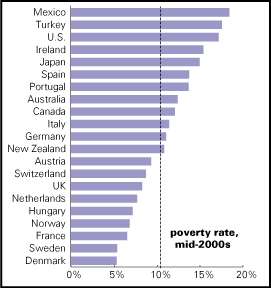
Americans may be some of the least healthy people in the rich part of this world, but we sure do feel good about ourselves!
That’s one of the more interesting revelations in the 2009 edition of the OECD’s Social Indicators. Americans lead the world in obesity, lag the world in life expectancy and infant mortality—yet 89% of us report ourselves to be in excellent health, just behind the world’s biggest health-boasters, New Zealanders, who beat us by a point in self-reported health, but who outlive us by more than two years.
This report got some coverage in our surviving newspapers, but most of the stories focused on the not-uninteresting news that the French spend more time than Americans sleeping and eating. But, of course, that shows what layabouts and sensualists they are. What the stories didn’t disclose is that we look like an overworked people with a dim future—aside from being some of the least healthy people in the richer neighborhoods of planet earth.
The general picture of the social and physical health of the U.S. isn’t pretty. In a summary table at the beginning of the volume, countries are rated with a red, yellow, or green symbol, depending on whether they fall in the bottom, middle, or top of the rankings on eight crucial indicators. The U.S. scores a yellow on six (among them employment, reading skills, the gender wage gap, and life expectancy), and a red on two (inequality and infant mortality). But we are near the top in income. Far poorer countries, like Hungary and the Czech Republic, do a lot better than this imperial colossus. Maybe it’s not so bad to have a Commie past.
And not only does the U.S. turn in an awful performance—we’ve been getting worse on six of the eight.
Slaving for pennies
The U.S. always turns in a spectacular performance on poverty indicators, and this version is no exception: not only do we have one of the highest poverty rates in the OECD (as the graph shows), our poor also tend to be quite poor. The average poor household in the U.S. has an income 38% below the poverty line (and poverty is defined here, as it often is in international comparisons, as an income less than half the national household median, with appropriate adjustments made for household size). The average for the OECD is 10 points lower, 28%. It’s in the low 20s in the Scandinavian countries, and in the mid-20s in France and Canada.
New Left Observer for more